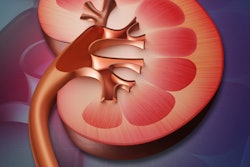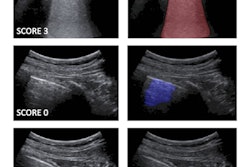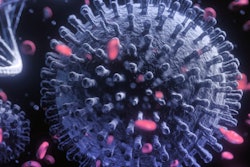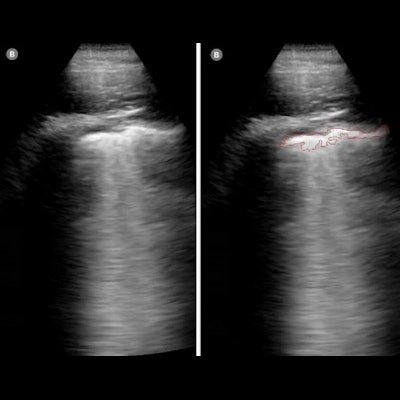
A quantitative lung ultrasound technique can be highly accurate for detecting and monitoring COVID-19, outperforming traditional lung texture features, according to research published April 2 in the Journal of the American College of Emergency Physicians.
In a pilot study, researchers led by Dr. Laith Sultan from the University of Pennsylvania used a semiautomated segmentation method to detect and quantitatively analyze pleural line (p-line) features on 20 ultrasound images. They found that the computer-based method was superior to lung texture features and perfectly distinguished between COVID-19 patients and normal subjects.
"This system, when implemented on ultrasound devices that are currently used in clinical practice, can be of great value in improving diagnosis and monitoring of COVID-19 patients," Sultan told AuntMinnie.com. "This would help overcome the current limitations in ultrasound imaging related to user dependence and subjectivity of diagnostic decisions."
Although lung ultrasound is useful in evaluating COVID-19 pneumonia, it's inherently a user-dependent modality and a lack of training can result in errors. Chest x-rays, the most common method for imaging COVID-19 patients, have low sensitivity. Although it's more sensitive, chest CT has been limited somewhat due to radiation exposure concerns and lack of availability in overextended healthcare facilities, according to the researchers.
"There continues to be need for alternative imaging methods that enable quick, low-cost, easy-to-use evaluation of COVID-19 patients," the authors noted.
The retrospective study was performed using 20 B-mode ultrasound images -- 10 from COVID-19 patients and 10 from normal cases -- acquired at La Paz University Hospital in Madrid. The authors developed software to segment the images and extract image features. After the software detects the p-line, it then extracts seven quantitative features: line thickness, thickness variation, projected intensity deviation, nonlinearity, tortuosity, brightness, and heterogeneity.
In addition, seven traditional quantitative lung texture features were also extracted and used as the basis for a predictive model: echointensity, heterogeneity, gray-level nonuniformity (GLNU), run-length nonuniformity (RLNU), gray-level cooccurrence matrices (GLCM), homogeneity, and entropy.
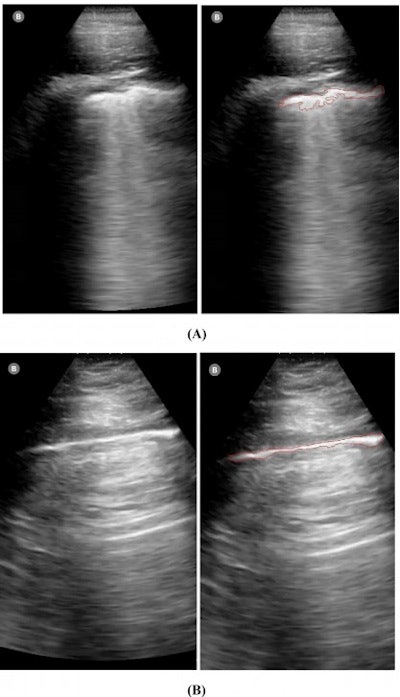 Examples of lung ultrasound images demonstrating the semiautomated detection method of pleural lines. The upper panel (A) shows a confirmed COVID-19 case with pleural thickening and irregularity. Right panel A shows pleural line detected with the semiautomated segmentation. The lower panel (B) shows an example of a normal case where the pleural line is outlined by semiautomated segmentation. Images and caption courtesy of the Journal of the American College of Emergency Physicians.
Examples of lung ultrasound images demonstrating the semiautomated detection method of pleural lines. The upper panel (A) shows a confirmed COVID-19 case with pleural thickening and irregularity. Right panel A shows pleural line detected with the semiautomated segmentation. The lower panel (B) shows an example of a normal case where the pleural line is outlined by semiautomated segmentation. Images and caption courtesy of the Journal of the American College of Emergency Physicians.The team found that six of seven p-line features shown in the computer-based technology had a significant difference between normal and COVID-19 cases, the lone exception being brightness. Meanwhile, only two of the seven traditional lung texture features produced such significant differences.
"The p-line model showed a superior separation of the COVID-19 from normal cases compared to the traditional lung texture model, whose features were closely distributed and even overlapping," Sultan said.
Combining results from all seven p-line features yielded perfect diagnostic performance.
| Performance for differentiating COVID-19 from normal cases | |||
| Sensitivity | Specificity | Area under the curve (AUC) | |
| P-line features | 100% | 100% | 1 |
| Traditional lung texture | 90% | 70% | 0.79 |
When implemented successfully in clinical practice, the technology has the potential to increase diagnostic confidence, especially in low-resource communities around the globe that lack experience in lung ultrasound, the authors said.
Future larger studies will incorporate advanced machine-learning methods to optimize the p-line detection algorithm for robustness and automation, according to the researchers.






